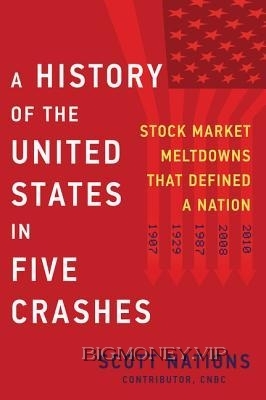
PANIC
1907
After decades of gray men in gray suits, Americans woke on the morning
of September 15, 1901, to find that possibly the single most energetic and
vivacious of their 78 million strong—Theodore Roosevelt—was their new
president after the assassination of William McKinley.
McKinley was elected twice and had been well liked. At fifty-eight, he
was still a young man, even by the standard of the day. Only five foot
seven, he was short but marked by a barrel chest, broad shoulders, and
ample gut, in those days a sign of health and prosperity. He had three years
left in his presidency, but on September 6, 1901, he was shot while standing
in a receiving line at the Pan-American Exposition in Buffalo, New York.
Just three days before, Leon Czolgosz, a twenty-eight-year-old anarchist,
had paid $4.50 for a chromed .32-caliber Iver Johnson revolver. As he
approached McKinley, Czolgosz fired twice, hitting the president in the
chest and the gut. McKinley survived the initial attack and gracefully
instructed his attendants to be careful when giving the news to his wife. Dr.
Matthew Mann was the surgeon available at the fairgrounds, and despite the
crude facilities and Mann being a professor of obstetrics and gynecology,
the decision was made for Dr. Mann to operate immediately rather than
transport the president to a local hospital. Even so, McKinley died eight
days later, on September 14.
At the time of the shooting, Roosevelt was on a hunting trip in the
remotest stretch of the Adirondacks, thirty-five miles from the town of
North Creek, New York. Rather than return to Washington, Roosevelt
continued hunting and McKinley died while Roosevelt was still working his
way over dark roads from the Tahawus Club hunting lodge to North Creek.
Roosevelt was still forty-three days from his forty-third birthday when he
was sworn in as president on September 14, 1901. When McKinley selected
him to replace his first vice president, who died in 1899 from a string of
heart ailments, Roosevelt was serving as governor of New York. Among the
reasons he got the post was that the powers-that-be in New York State
wanted Roosevelt out of the governorship and making his mischief
elsewhere.
Roosevelt had been the ideal candidate for governor of New York when
he returned from the Spanish-American War as a hero. Never mind that
some of the hero-making had been more Roosevelt’s premeditated doing
than sheer gallantry on the battlefield, although there was much of that.
Roosevelt was a master of self-promotion. There was so little room on the
ship taking his regiment to Cuba that only Roosevelt and the senior officers
of the “Rough Riders” were able to bring their mounts—many of the Rough
Riders had to walk into battle. But Roosevelt made sure there was room on
board for reporters, photographers, and even a couple of early, crude movie
cameras, despite the objections of the United States Army.
The war lasted less than four months, but the experience seemed to
teach Roosevelt that every subsequent professional and political conflict
should be charged with the drama and righteousness of this armed combat.
Even relatively minor disagreements with potentially helpful businessmen
evoked in him the furor of battle. For Roosevelt, losing the battle or being
killed was preferable to missing the action entirely. When asked about the
possibility that the war would conclude before he got there, he said that
would be “awful.” He professed the hope that all his officers would be




